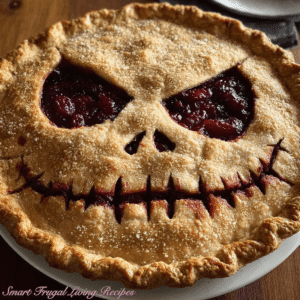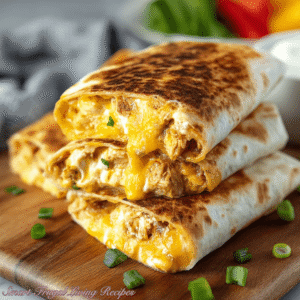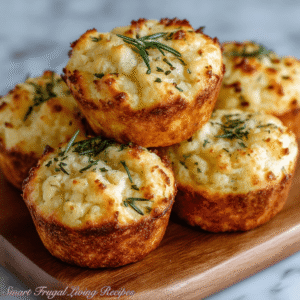Introduction
There’s something magical about Snickerdoodle cookies. The moment you bite into one, you’re greeted with that signature combination of buttery sweetness and warm cinnamon spice, all wrapped up in a tender, chewy cookie. For me, these cookies aren’t just a treat—they’re a memory. I remember pulling trays of golden snickerdoodles out of the oven as a kid, the cinnamon sugar scent filling the whole kitchen, and that first taste being pure joy.
So what makes the best snickerdoodle cookie recipe? It all comes down to balance. A snickerdoodle should be slightly crisp around the edges but soft and chewy in the middle, with a coating of cinnamon sugar that gives it that comforting warmth in every bite. Unlike sugar cookies, which can be plain and sweet, snickerdoodles have a tangy note from cream of tartar that makes them stand out. That little twist of flavor is what transforms a simple cookie into something special.
These cookies are also timeless. They’ve been around for generations, bringing comfort to homes across America. Whether you’re baking them for a holiday cookie swap, a family gathering, or just a cozy weekend treat, they always have a way of disappearing quickly from the plate.
If you love learning about the history of classic desserts, you might enjoy Smithsonian Magazine’s exploration of cookie traditions. For a more modern take on baking science, King Arthur Baking offers great insights into how different ingredients affect texture and flavor.
Now, let’s get into the recipe that will give you the perfect batch of soft, chewy snickerdoodles every single time.
The Best Snickerdoodle Cookie Recipe

Snickerdoodle Cookie
Ingredients
Method
- Cream Butter and Sugar: In a large mixing bowl, beat the softened butter and sugar together until light and fluffy, about 2–3 minutes.
- Add Eggs and Vanilla: Mix in the eggs one at a time, then stir in the vanilla until well combined.
- Combine Dry Ingredients: In a separate bowl, whisk together flour, cream of tartar, baking soda, and salt.
- Mix the Dough: Gradually add the dry ingredients to the wet mixture, mixing just until combined. The dough should be soft but not sticky.
- Chill (Optional but Recommended): For thicker cookies with less spread, cover the dough and refrigerate for 30 minutes.
- Preheat Oven: Preheat your oven to 350°F (175°C) and line baking sheets with parchment paper.
- Prepare Cinnamon-Sugar Coating: In a small bowl, mix together the ¼ cup sugar and cinnamon.
- Shape and Roll: Scoop tablespoon-sized portions of dough, roll into balls, and coat thoroughly in the cinnamon-sugar mixture.
- Bake: Place dough balls 2 inches apart on the prepared baking sheets. Bake for 8–10 minutes, until edges are set but centers look slightly soft.
- Cool and Enjoy: Allow cookies to cool on the baking sheet for 5 minutes before transferring to a wire rack.
Notes
- Chilling helps prevent spreading, but if you prefer thin and chewy cookies, you can skip this step.
- For a bakery-style look, press dough balls slightly flat before baking.
- The tang from cream of tartar is traditional, but you can adjust the amount to your preference.
Advanced Techniques for Perfect Snickerdoodles
Why Creaming Butter and Sugar Properly Matters
Creaming the butter and sugar until light and fluffy isn’t just a step—it’s the foundation for the right texture. This process whips air into the dough, helping the cookies rise slightly while baking. If you skip this or rush it, your cookies may come out dense instead of tender. I usually set my mixer on medium speed for a solid 2–3 minutes, and you’ll notice the mixture turns pale and fluffy—exactly what you want.
Mastering the Chill for Thicker Cookies
While chilling isn’t mandatory, it makes a world of difference. Chilling the dough solidifies the fat in the butter, which slows spreading in the oven. The result? Thicker, chewier cookies with a soft center. When I want extra-thick cookies, I’ll chill the dough for a full hour. For a quick fix, even 15–20 minutes in the freezer works wonders.
Rolling Twice in Cinnamon Sugar for Extra Flavor
One of my favorite tricks is to roll the cookie dough balls twice in the cinnamon sugar mixture. That extra layer gives the cookies a stronger cinnamon kick and a slightly crunchier exterior. It also makes them look beautifully coated, almost sparkling when they come out of the oven.
Baking on Parchment vs. Silicone Mats
Both work, but parchment paper tends to give the cookies slightly crisper bottoms, while silicone mats make them softer all around. I like to use parchment if I’m baking for a party and want that crisp edge, but silicone mats are my go-to when baking for family snacking because they make cleanup so easy.
Adjusting Bake Time for Your Perfect Texture
Bake time is everything with snickerdoodles. If you love them softer, pull them out when they look slightly underbaked in the center. They’ll continue to cook on the sheet as they cool. For crispier cookies, leave them in for the full 10 minutes or even 11. Personally, I always go for the slightly underdone, chewy version—it’s heaven.

Storage, Shelf Life, and Maintenance Tips
Keeping Snickerdoodles Soft for Days
The best way to keep snickerdoodles soft is to store them in an airtight container with a slice of bread. The bread provides moisture that the cookies will absorb, keeping them chewy for 4–5 days. Just replace the bread slice as it dries out.
Freezing Cookie Dough Balls for Later
Snickerdoodle dough freezes beautifully. Roll the dough into balls, coat with cinnamon sugar, and freeze on a tray until solid. Transfer to a freezer bag and bake straight from frozen, adding 2–3 minutes to the baking time. Perfect for when you want just a few cookies at a time.
Freezing Baked Cookies Without Losing Quality
You can also freeze fully baked snickerdoodles. Cool them completely, then layer them between sheets of parchment in a freezer-safe container. They’ll keep well for up to 2 months. To enjoy, just let them thaw at room temperature for about 30 minutes.
Reviving Day-Old Cookies for Freshness
If your cookies lose a bit of softness, don’t worry. Pop them in the microwave for 8–10 seconds, and they’ll taste like they just came out of the oven. The heat reactivates the butter and sugar, bringing back that tender chewiness.
Using Snickerdoodles for Dessert Creations
Leftover snickerdoodles can be repurposed into some fun desserts. Crush them into crumbs for a cheesecake crust, layer them in a trifle with whipped cream and fruit, or use them to sandwich vanilla ice cream. Trust me, they’re even more magical that way.

Dietary Adaptations and Substitutions
Making Gluten-Free Snickerdoodles That Still Taste Amazing
Gluten-free baking can be tricky, but snickerdoodles adapt beautifully. Just use a 1:1 gluten-free flour blend that includes xanthan gum. The texture is nearly identical to the original, and the cinnamon-sugar coating hides any minor differences.
Lower-Sugar Snickerdoodles for a Healthier Treat
If you want to reduce sugar, you can substitute half of the sugar with a baking-approved sugar alternative like monk fruit sweetener. I’ve tested this, and while the cookies are a touch less chewy, they still taste delicious.
Making Dairy-Free Snickerdoodles Without Sacrificing Flavor
Swap out the butter for a good-quality vegan butter or margarine. Coconut oil also works, though it gives a subtle coconut flavor. Paired with cinnamon, it’s actually a pretty tasty twist!
Egg-Free Snickerdoodles for Allergy-Friendly Baking
Eggs can be replaced with flax eggs (1 tablespoon flaxseed meal + 3 tablespoons water per egg). The cookies turn out slightly denser but still soft and flavorful. This is a great option if you’re baking for someone with an egg allergy.
Keto-Friendly Snickerdoodles That Work
For a keto version, use almond flour instead of regular flour, and swap sugar for erythritol. The texture is a little different—slightly more crumbly—but the cinnamon sugar flavor shines through beautifully.

FAQs About Snickerdoodles
Why Do Snickerdoodles Need Cream of Tartar?
Cream of tartar gives snickerdoodles their signature tangy flavor and chewy texture. Without it, the cookies taste more like plain sugar cookies. If you don’t have it on hand, you can substitute with baking powder, but the flavor won’t be quite the same.
Can I Make Snickerdoodles Without Chilling the Dough?
Yes! Chilling isn’t essential, but it does help control spreading. If you skip the chill, expect thinner cookies with crispier edges. They’ll still be delicious, just with a slightly different texture.
How Do I Know When Snickerdoodles Are Done?
The trick is to pull them out when the edges are set, but the centers still look a little underdone. They’ll continue to firm up as they cool on the baking sheet. Overbaking is the quickest way to lose that soft, chewy texture.
What’s the Difference Between Snickerdoodles and Sugar Cookies?
The biggest difference is the cream of tartar. Sugar cookies are sweet and buttery, but snickerdoodles have that subtle tang and the unmistakable cinnamon-sugar coating. It’s a small change that makes a huge flavor difference.
Can I Add Other Flavors to Snickerdoodles?
Absolutely! You can add nutmeg, cardamom, or even a splash of almond extract for a twist. I once added pumpkin spice in the fall, and it was a huge hit. Snickerdoodles are surprisingly versatile, so don’t be afraid to experiment.

Conclusion & Final Thoughts
There’s a reason why snickerdoodles have stood the test of time. They’re simple to make, packed with flavor, and always bring comfort. For me, the best part about baking these cookies is how they fill the house with the irresistible scent of cinnamon sugar. It’s one of those recipes that makes any day feel instantly cozier.
What I love about this recipe is how adaptable it is. You can bake them soft and chewy or crisp and golden, depending on your mood. You can make them classic with just cinnamon sugar, or you can add fun twists like nutmeg or cardamom. And no matter what, they always come out tasting like pure nostalgia.
Whether you’re baking these for the holidays, packing them into lunchboxes, or enjoying them with a cup of coffee on a quiet afternoon, they’re the kind of cookie that brings smiles every single time. They’re unfussy, reliable, and just downright delicious.
So next time you’re craving something sweet and comforting, give The Best Snickerdoodle Cookie Recipe a try. You’ll end up with soft, chewy cookies that feel like a warm hug—and I promise, you’ll be making them again and again.



